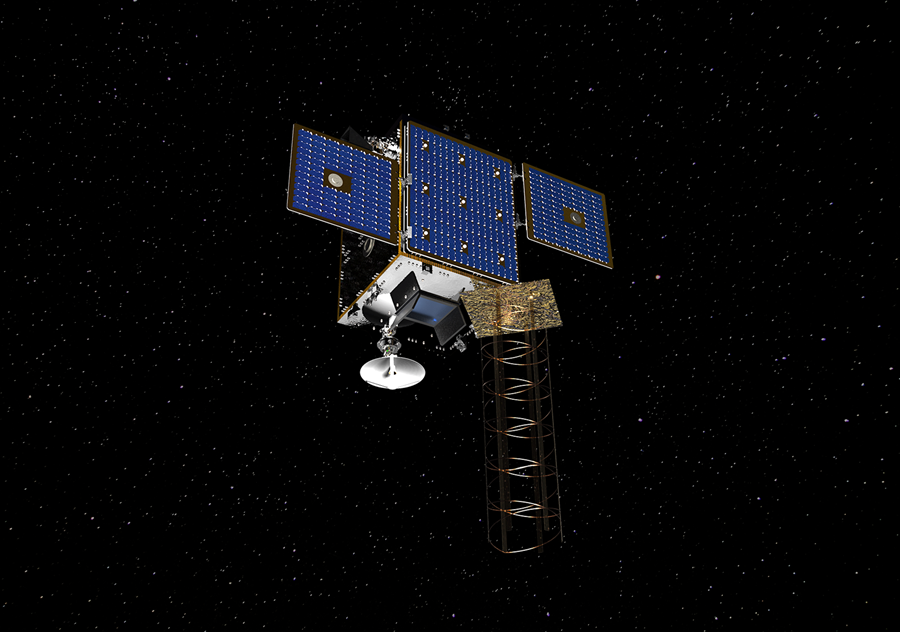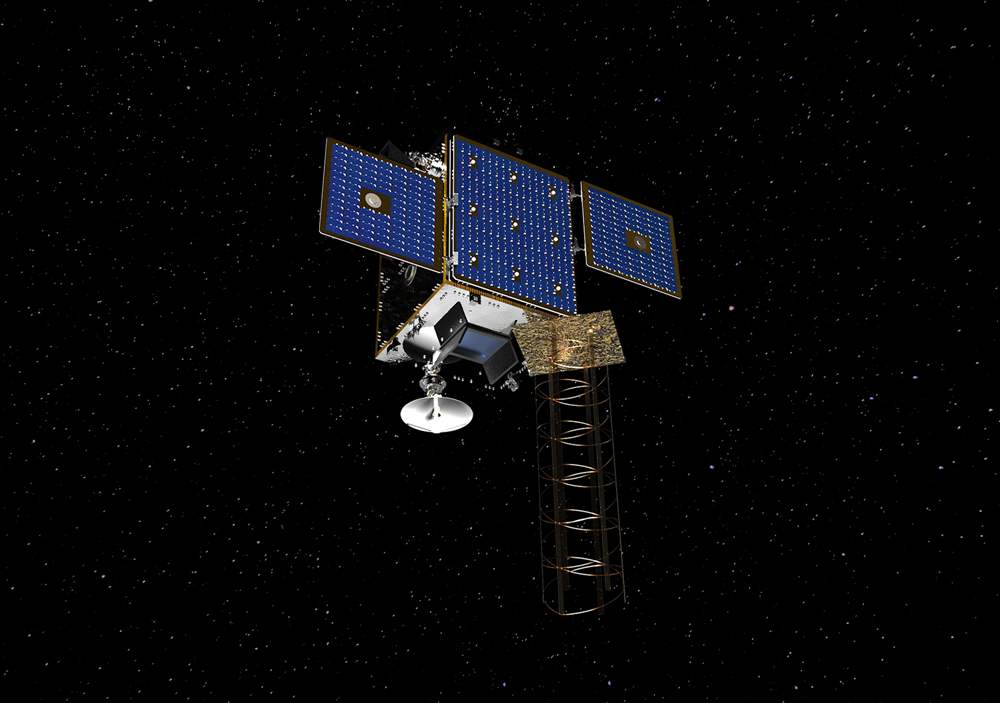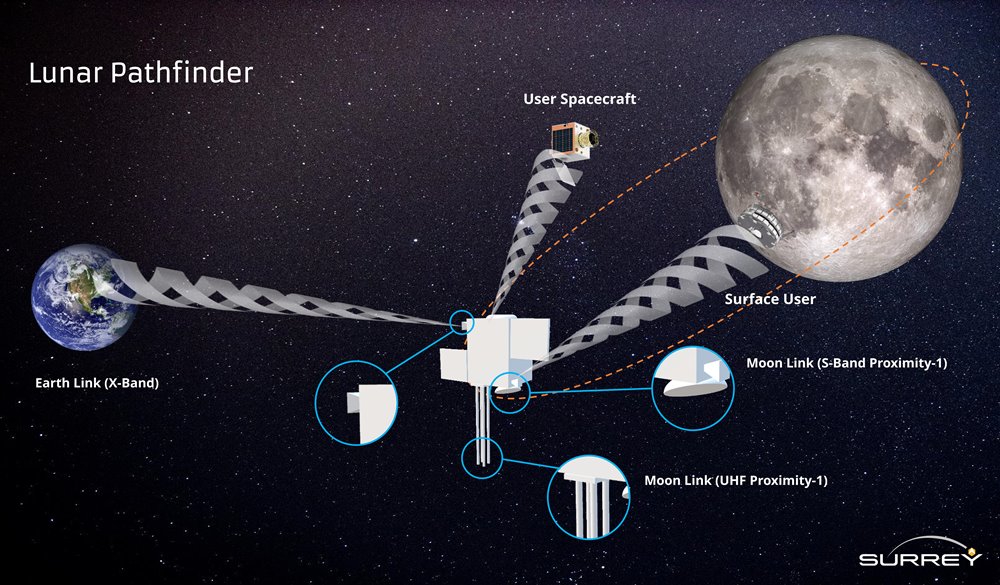
Lunar Pathfinder is a Commercial Lunar Mission Support Service to provide data services via S-band and UHF links to lunar assets, and an X-band link to Earth.
Following the European Space Agency Ministerial Council Space19+ meeting in Seville at which the UK Space Agency confirmed it will invest £374 million per year with ESA, Surrey Satellite Technology Ltd (SSTL) is pleased to announce the kick-off for the implementation phase of its Lunar data-relay spacecraft, Lunar Pathfinder.
Phil Brownnett, SSTL’s Managing Director said “Lunar Pathfinder will be the first commercial service to address the need for data relay around the Moon, and will not only demonstrate an innovative business idea, but we fully expect it to also stimulate the emerging Lunar market. By pioneering a commercial solution and service delivery model in lunar orbit, SSTL and ESA are opening the door to providing services to the solar system, and contributing to the scientific progress of deep space exploration.”
The Lunar Pathfinder spacecraft is designed to provide affordable communications services to lunar missions via S-band and UHF links to lunar assets on the surface and in orbit around the Moon, and an X-band link to Earth. As early as Q4 2022, the 280 kg Lunar Pathfinder spacecraft will be a mission enabler for polar and far-side missions, which, without direct line of sight of the Earth, would otherwise have to procure their own communications relay spacecraft. Lunar Pathfinder is a more cost effective alternative to Direct-to-Earth solutions and a credible alternative to institutional deep-space ground stations, offering orbiters and near-side missions a better availability, enhanced safety and improved data-rate.
”The Moon is a cornerstone of ESA’s exploration strategy,” says David Parker, ESA’s director of human and robotic exploration, “this decade we will see humans and robots visit uncharted territory and return with new discoveries, communications is key to send scientific and operational data to Earth.”
“We are returning to the Moon with commercial and international partners, and the Lunar Pathfinder mission will be an integral part.”
To support booming demand from Lunar missions and a clear goal in the scientific community to undertake detailed study and analysis of the Aitken Basin, Lunar Pathfinder intends to operate in a stable elliptical orbit to provide long duration visibility of the Southern Lunar Hemisphere each day, with maximum opportunities for the transmission and reception of data between Earth and the lunar surface. NASA’s Artemis programme also calls for “landing the first American woman and next American man at the South Pole of the Moon by 2024, followed by a sustained presence on and around the Moon by 2028” and Lunar Pathfinder is accordingly working towards a launch in Q4 2022 to support early NASA missions.
In parallel to the Lunar Pathfinder mission SSTL has been working on future plans for a constellation of spacecraft around the Moon, capable of providing enhanced communications, as well as navigation services for the Lunar market as it grows from exploration to commercial exploitation and even tourism.
Acting both as technology and service demonstrator, Lunar Pathfinder is the opportunity for scientific and commercial mission developers to support the development, test and standardisation of Lunar communication infrastructure, and for emerging off-planet telcos to acquire experience of lunar asset operations and off-planet service delivery. Lunar Pathfinder is thus laying the foundation to support sustainable science and exploration for the next twenty years and beyond – bringing with it the possibility that when humans next set foot on the Moon we will be hearing not “Houston we’ve landed” but instead “Guildford…
ENDS
Notes to editor:
Full size accompanying images for this press release can be downloaded at the bottom of this page.
Press Contact:
Joelle Sykes, PR Manager, SSTL
Tel: +44 (0)1483 804243
Mob: 07775 000853
Email: j.sykes@sstl.co.uk
About SSTL
Surrey Satellite Technology Limited (SSTL) is at the forefront of space innovation and is the world's leading small satellite company, delivering customisable complete mission solutions for Earth observation, science, communications, navigation, in-orbit debris removal and servicing and exploration beyond Earth infrastructure.
Since 1981, SSTL has built and launched more than 60 satellites for 20 international customers, as well as providing training and development programmes, consultancy services, and mission studies for ESA, NASA, international governments and commercial customers.
SSTL is well known for innovative missions such as the CARBONITE video imaging satellites, the NovaSAR S-band radar imaging satellite and the RemoveDEBRIS space debris removal technology demonstrator.
Headquartered in Guildford, UK, SSTL is part of Airbus.
About the European Space Agency
The European Space Agency (ESA) provides Europe’s gateway to space.
ESA is an intergovernmental organisation, created in 1975, with the mission to shape the development of Europe’s space capability and ensure that investment in space delivers benefits to the citizens of Europe and the world.
ESA has 22 Member States: Austria, Belgium, the Czech Republic, Denmark, Estonia, Finland, France, Germany, Greece, Hungary, Ireland, Italy, Luxembourg, the Netherlands, Norway, Poland, Portugal, Romania, Spain, Sweden, Switzerland and the United Kingdom, of which 20 are Member States of the EU. Slovenia is an Associate Member.
ESA has established formal cooperation with seven other Member States of the EU. Canada takes part in some ESA programmes under a Cooperation Agreement.
By coordinating the financial and intellectual resources of its members, ESA can undertake programmes and activities far beyond the scope of any single European country. It is working in particular with the EU on implementing the Galileo and Copernicus programmes.
Download PDF
